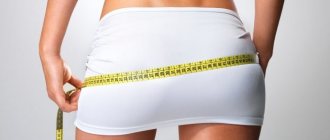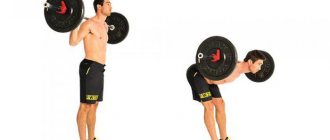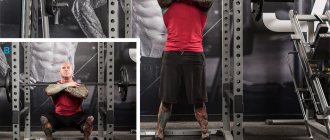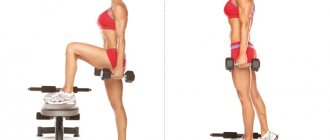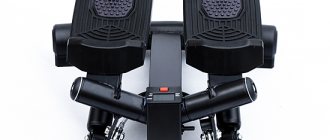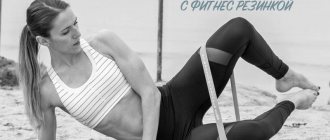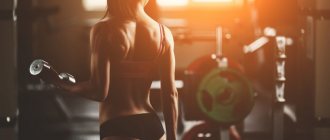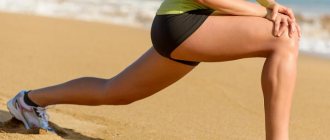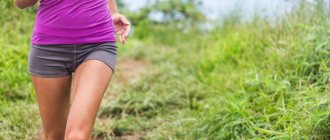Forward swing exercise
Initially, it is necessary to understand which muscles receive the main load in functioning when performing various types of leg swings necessary for weight loss and proper leg training.
- The lumbar back and the area of the back of the thighs begin to actively work when performing gymnastics with the leg straightened at the knee, and when lifting the leg bent at the knee or on all fours, the load is distributed to all muscle fibers localized in the buttocks area.
- When swinging your legs forward, intensive development of muscle fibers on the front surface of the thigh, called quadriceps, is activated.
- Performing leg abductions outward, or to the side, helps to work the gluteus medius muscles.
- Inward swings help work the adductor muscles, or inner thigh.
Experts recommend combining all types of leg swings for the most effective and comprehensive workout of the muscles in the hips and buttocks.
Important! It is recommended to perform gymnastics with leg swings for people who have any pathological problems in the knee area, but only in a standing or lying position.
In order to practice this type of gymnastics, you do not need to acquire any special equipment and such classes can be carried out right at home. Leg swings can be done both without additional equipment and with weights attached to the ankle of the leg and helping to achieve the greatest efficiency. There are a number of special rules that explain how to properly swing your legs in order to achieve maximum benefit and visibility of the result.
To work the large gluteal muscle fibers as effectively as possible, you need to perform fairly simple gymnastic exercises with leg swings in a backward direction. So, to perform this exercise, you must initially turn your face to the support and firmly grasp it with both hands. You just need to keep your back straight, like a ballerina.
After this, you can begin to directly perform gymnastics.
- Slowly move one leg, straightened at the knee, back and raise it to the maximum possible height in the upward direction
- After this, return to the starting position and repeat this exercise again 10 times on each leg.
The correct execution of this exercise should be indicated by active tension in the gluteal muscles. Here, the main thing is to perform leg swings, using only the legs and hips themselves, the torso should always be in a straight position with a tucked and tucked stomach.
Performing the following exercises intensively helps strengthen the muscles around the knee area, as well as the buttocks and thighs. To do this, you need to stand sideways to the support and slowly perform alternating lifts of both legs 20 times on each.
Important! When swinging your legs forward, keep a straight posture, and your toes on your legs straightened at the knees must be pulled forward when lifting.
Muscle work
First of all, swinging your legs to the side affects the area of the buttocks, namely the gluteus medius and minimus muscles, the tensor fascia lata. The core stabilizers are also loaded, namely: the oblique abdominal muscles, lower back, and spinal extensors. Additionally, the movement engages the small muscles of the legs.
In the classic version, the gluteus medius and minimus muscles work.
Depending on the starting position, the trajectory of the leg during the swing and the turn of the foot, the quadriceps, hamstrings and gluteus maximus muscles may be involved in the work.
Load shift when changing the position of the working leg.
It is worth understanding that swings are strength exercises. Their implementation can significantly improve the shape of the buttocks, but by themselves they do not contribute to weight loss. If your goal is to reduce volume, supplement your workouts with cardio and reduce your caloric intake.
We invite you to familiarize yourself with Leg training at home. Exercises for losing weight on legs
And now we will swing our legs back. There is nothing difficult about this either, now you will see it. So, we turn to face our support and grab it tightly with both hands. Keep your back straight (remember the ballerina again). After the starting position is accepted, we begin to move one leg back with a smooth movement and lift it as high as possible.
Tip: you should try to raise your hip as high as possible, but do not tilt your torso forward. The leg swing is performed only through the efforts of the hips. The stomach should be tense and tucked.
Purpose
Leg swings are a group of exercises aimed at working the hips and buttocks. The advantage is the ability to choose a suitable implementation option. With the help of swings, it is possible to work the hips (external, internal, front and back), gluteal and middle muscles. The correct technique is a chance to reduce the amount of excess fat, tighten muscles, and give a sporty figure.
It is worth noting that the result depends on the type of swing chosen. The options are as follows:
- Swing back. When the legs are pulled back, the following groups work:
- Gluteus maximus muscle.
The back (biceps) of the thigh.
- Swing forward. If your legs move forward, the load goes to the quadriceps, that is, the front of the thigh.
- Taking your legs to the side (outward) works your buttocks (middle part).
- The legs are abducted inward - the adductor muscle group (inner thigh) is in action.
If the work is carried out with a straight leg, then the main load is taken by the back of the thigh (plus the lumbar region). If the legs are bent at the knee joint and the exercise is done on all fours, then the buttocks work.
To achieve results, it is worth including four execution options in your training program. In this case, the load is placed on the legs, muscles of the buttocks and thighs. Moreover, after 2-3 months the body takes on the expected shape.
The main advantage is that it does not require additional equipment or tools. The training process can be easily organized at home. The only thing you need is weights for your legs, but they can also be done using improvised means. If classes are held in the gym, the range of exercises expands. The work here involves hip adduction (abduction) simulators, cable simulators and other equipment.
Leg swings are an exercise characterized by minimal stress on the knee joints. Thanks to this, people with knee problems can easily do it. The only execution option that should be avoided is the position on all fours, because in such a situation the kneecaps receive the greatest load.
So where to start?
If you are reading this article, then at least you have the desire to look good.
Remember, to achieve the desired result quickly, it is better to go to the gym with a trainer. But there is reason to rejoice: at home within a month you can achieve incredible results that others will appreciate.
After all, the gluteal muscles quickly get used to physical activity that is performed regularly.
Remember that in every complex that is designed to improve your overall figure, there are a number of exercises for the buttocks.
Whatever exercises you choose, there will always be results if you approach this matter responsibly!
You absolutely do not need any special skills or abilities. One recommendation would be to stock up on a gymnastics mat.
In principle, carpet runners, a carpet, a yoga mat, a rubber track - anything that does not have a slippery surface - are also suitable.
Before you start your main workout, you need to do a warm-up. You should know which exercises are the most effective for warming up.
It all depends on which muscles are selected for warm-up exercises before the main workout.
For slender and toned thighs and buttocks, you must definitely add stretching exercises for the gluteal muscle to your complex. Stretching can be done not only in fitness centers, but also at home.
You may be interested in How to get a toned and firm butt with squats
Rules for performing exercises
Many leading fitness center specialists claim that leg swings are one of the most effective types of gymnastics that help create the ideal shape of legs and hips.
- Evenly distributes the load on the thigh muscles, ensuring complete control over the body's immobility.
- Maximum level of leg straightening with maximum load on the muscles.
- For gymnastics to be as beneficial as possible, you must perform at least three approaches with 20 lifts of each leg.
- To increase the load on the muscles of the buttocks and thighs, it is recommended to use weights.
- Ensure correct breathing: when relaxing, inhale, when the body is tense, exhale.
- In order to lose weight, you need to combine leg swings with peeling, wrapping with essential oils, as well as with the right diet.
Now let's figure out how to swing your legs to the side and back, namely, let's look at the detailed execution technique.
What results can be achieved?
With the help of swings back, forward or to the sides, several problems can be solved:
- Elimination of excess fat (weight loss). If the goal is weight loss, then including swings in your training program will speed up the process. By concentrating on problem areas (buttocks or thighs), it is easier to tone the muscles, give your figure definition, normalize blood flow and reduce the risk of cellulite. To achieve your goals, it is important not only to train, but also to eat right. In this case, the calorie deficit will be higher, and the result in the form of beautiful buttocks will come faster. Many people perceive this advice as a recommendation for fasting. But that's not true. It is enough to reduce the amount of simple carbohydrates and add protein to your diet. Another key point is the pace of the exercise. To lose weight, you should move your legs at a fairly high speed, while doing the greatest number of repetitions. An additional plus is the use of weights. The number of sets is 3-5, the number of repetitions is 15-20.
- Mass gain. If the goal is not losing weight, but gaining muscle mass in the buttocks and thighs, then the exercises in question will also be useful. The only thing is that the approach to organizing training changes slightly. Initially, it is worth thinking about additional load, without which the training process will be useless. If classes take place in the gym, then it is worth using exercise equipment (a crossover will do). At home, use an expander or weights. The exercise is performed at a slow pace. The permissible pause is no more than a second at the point of greatest tension in the muscle fibers. The number of approaches is 3-5, the number of repetitions is 12-15. The result will be better if swings are done together with squats, lunges and other exercises that involve the legs and buttocks.
Losing weight with swings
This is one of the universal exercises. With its help you can both lose weight and build your legs. It is worth noting that even with weight loss, the legs become more prominent and beautiful. Swings help you lose weight because they burn off excess calories. When there is a lack of calories from food, fat comes into play. It provides the body with energy during training. In addition to burning fat, this exercise is useful because it tones your legs and butt.
Interesting! Even at rest, the body will expend energy. Swings also improve blood circulation in the legs, which will prevent cellulite from progressing.
To use fat as a resource, you need not only to train as much as possible, but also to adhere to a balanced diet. This will help create a calorie deficit, which will help you lose fat. Under no circumstances should you starve or go on a strict diet - this will negate the results of your studies.
Leg swings help to lose weight on the inner surface of the ankles if you do them like this:
- Lie on your left side, bend your right leg at the knee and place it slightly in front of your left. You can lie down completely on the mat or perform the exercise with your head raised. Its main part is that you need to swing with your left leg straightened inward. Then you should turn to the right side and repeat.
- Stand with your back to the support, hold on to it with one hand, and place the other on your belt. Perform swings first with your right leg (straight) in the appropriate direction, then with the same leg to the left. This will strengthen the inner thighs, but will also prevent the outer thighs from relaxing. Then they do the same with the left foot.
- Attach weights to your ankles, lie on your back, raise your legs at a right angle, trying not to bend them. Then they should be slowly pulled apart and brought together slowly, too.
- Take a cat pose with emphasis on your palms and knees. Without straightening one leg, rhythmically move it to the side, then do the same with the other.
- Get on your knees, slightly leaning your body to the left and hold on to the support on this side. Without straightening, lift the right leg to the side to the level of the pelvis. Run several times. Then do the same with the other leg.
- Lie on your side, leaning on your elbow. Make circular movements with the leg that is on top, bending and straightening it. Change position, sitting on the other side, and do the same.
These exercises should be in addition to squats and wide lunges to the sides.
Remember two important rules for slim people:
- You need to eat less than you expend.
- Physical exercise does not affect body fat.
We invite you to familiarize yourself with Nutrition for gaining muscle mass for girls: preparing a diet and an example menu for a week for muscle growth for women
Let's look at why this happens.
First of all, muscle and fat have nothing to do with each other. We shed pounds when the body uses body fat as fuel, which only happens when the carbohydrates we eat for the day run out. This explains the first rule - to lose weight in your legs, belly and everything else, you will have to adjust your diet.
Secondly, you can't lose weight in just one place. Even if you perform swings correctly, but do only this, even 1000 repetitions 30 times a day, you will not achieve a positive effect. Every girl has a problem area - the place where fat accumulates fastest and disappears slowest. If in your case it is your legs, you should be patient.
Why then do them?
Here’s another rule for you: it’s easier for the body to take energy from muscles than to break down fats for this. What does it mean? If you eat healthier but don't exercise, your muscles will weaken and become invisible.
Don't like lifting weights in the gym? This won't be necessary. There are many effective exercises for several muscle groups, one of which is swings. Why should we include them in our training?
- They use many muscles. The hamstrings, quads, glutes, adductors and abductors are not even a third of the muscles you use to swing your leg.
- Performing the exercise requires a lot of calories, which is so important for losing weight.
- Swings improve blood circulation, especially in the hips, which affects the condition of the skin (helps get rid of cellulite) and metabolism.
As you exhale, lift your leg with your toe up not below the level of your pelvis, but as high as possible. Raising your leg as high as possible, at the same time as you swing wide, bring your hand closer, touching the toe of your leg. If you started the exercise with your left leg, move your right hand closer and vice versa.
Swing to the side
These simple exercises have become known to everyone since school days, but not everyone thinks about the benefits of doing them for the inner thighs and the formation of a beautiful butt.
- take the starting position, standing, turning your left side to a support in the form of a wall, chair or table;
- straighten your back and tighten your stomach;
- performing alternate lifts with straightened legs, when doing which, you can imagine yourself in the role of a ballerina;
- with your left hand you need to lean on the support;
- the right leg, straightened at the knee, must be raised to the side (outward) to the maximum possible height;
- after reaching the maximum height level, the leg must be slowly lowered to its original position;
- When the leg touches the floor surface, it must again be immediately raised to the side.
After 15-20 such swings with the right leg, it is necessary to change the position of the body, turning to the support with the right side and perform the same number of lifts for the left leg.
Please note: When raising your leg, the body should be in a straight position, you should not help yourself by bending to the side, and the leg should be in line with the body.
Leg swings: basic knowledge
Swings with straight or bent knees should be done at every lesson, and not from time to time.
It is necessary to ensure that the muscles of the trained area of the body, and not the back, are tensed, that is, control the posture. It is important to pay attention to side swings. They work the gluteus medius muscles to keep this area round. With this option, the adductor and femoral muscles are also involved. But for the proportionality of the figure, it is equally important to do abductions back and forth. Swings are also useful because they help get rid of cellulite, “breeches” on the hips, and make your legs slimmer. Therefore, your training should include rhythmic movements from standing positions, lying on your side, from the cat pose, using weights, elastic bands on the cuff, and a crossover.
Muscles that perform lateral bending and stabilize the position of the spine
: external oblique, internal oblique, quadratus lumborum, erector spinae (spinalis, longissimus, iliocostalis), semispinalis, deep spinal group, rectus abdominis, transverse abdominis.
Abductor muscles of the thigh
: gluteus medius, gluteus minimus, tensor fascia lata, sartorius muscle.
Swings (forward, backward, sideways) are considered purposeful actions that can be performed with a load, that is, on a crossover (“pendulum”). This option provides greater efficiency, which demonstrates the clear meaning of performing such movements in general. As a result of a properly designed program and optimally selected weight, pumping of the buttocks and hips will be done more intensively.
Execution technique
Now let's move on to the main thing - the technique of each exercise option:
- Swing back. As already mentioned, the large buttock muscles and hamstrings work here. You are allowed to take any comfortable position - resting on your elbows or standing on straight legs. The last position is suitable when performed on a simulator. Additionally, standing leg kicks are a great option if you have knee problems. Proceed as follows:
- Stand up straight and rest your hands on a special support (this can be a table, chair). Secure your lumbar spine in such a way as to prevent deflection during the exercise.
The legs are alternately retracted back to the maximum. Pay attention to your foot - your heel should point upward. Try not to change the position of your back, but work with your buttocks and thighs. Then lower your foot to the floor.
The second option is to move the leg back into a kneeling position. Advantages of this option:
- Great load on muscles.
- Ability to increase range of motion.
- Convenient choice between straight and bent leg swings.
To transfer the load to the posterior thigh, follow the technique below:
- Take your starting position. The emphasis is on four points - the knee and elbow joints. Watch your back and lumbar region - no bending or sagging. The cervical region is an extension of the back (there is no need to lift the head).
- Pull your straight leg up. At the same time, try to let your heel go first. Lifting is carried out through the lumbar region, and the spine remains straight. Then lower your leg and repeat the movement the required number of times.
To better work the muscles of the buttocks, the technique should be as follows:
- The starting position is similar to that described above. The difference is that the leg should not be pushed back.
- Slightly bend your leg at the knee joint, lift it back and straighten it at the top position. Imagine that the main task is to push through the ceiling. In this case, you need to feel how the gluteal muscles work.
Many people do the exercise on a soft mat, but it is uncomfortable. The arms are stable, but the pressure on the pelvic bones is excessive.
- Take a standing position. The emphasis should be a wall or a securely installed piece of furniture on which you can rest your hands.
Shorten your foot and begin lifting your straight leg to the greatest height. The main thing is to keep your back straight.
- Straighten up and place one hand against the wall (or other support).
Stretch your foot and pull your straightened leg to the side to the maximum. Watch your spine - it should remain straight.
If the exercise is done on all fours, then proceed as follows:
- Support yourself on your elbows and knees. One of the hands rests on the surface with the palm, and the foot on the same side is lifted. Straighten your working leg and move it to the side.
- Lift and smoothly return it to the starting position. In cases where performing an exercise with a straight leg causes problems, bending in the knee joint is allowed.
Side lying position. Here's the technique:
- Take a position on your side.
- Support your head with one hand (you can put it on your elbow), and place the other in front of you. Bend your lower leg at the knee joint (this guarantees additional stability).
- Raise the top one as far as you can and slowly lower it.
- Take a position with your side to the machine, your back should be straight.
Pull up your toes and lift your working leg. Make swings in such a way that it is raised as high as possible and is in front of the support.
If the exercise is done on the side, then proceed as follows:
- With one hand, rest on your elbow joint. Bend your top leg at the knee and place it on your foot, and place your other hand slightly in front to provide stability.
- Raise your lower leg to its maximum position and return it to its place.
Swing the leg bent back with emphasis on the elbows
| To increase the load, the exercise can be performed with emphasis on the elbows. Get on your knees, bend your legs at a right angle, place your hands shoulder-width apart, rest on your elbows. Look forward. |
| Without straightening the leg at the knee joint, using the force of the gluteal muscle, lift your leg up so that the thigh is in line with the body, while the heel should be directly above the knee and point directly at the ceiling. When lifting your leg up, try to pull it as high as possible, the upper part of the thigh is parallel to the floor, the leg is bent at 90 degrees. Stay in this position for a second. Then return to the starting position. The exercise is performed slowly, with maximum tension in the buttock muscles. Tighten your abdominal muscles (the abdominal muscles are tense) and fix your lower back; only your leg should “work”. Don't hold your breath |
| If everything is done correctly, you will feel a strong, similar to a slight burning, tension in the gluteal muscle. Don’t be alarmed, this means that the muscle worked well, and in the process of work, areas were involved that cannot be pumped up without doing special exercises for the hips and buttocks. Don't forget to relieve tension from tired muscles by sitting on your knees, lowering your body onto your hips and stretching your arms forward. Relax the muscles of your back, legs, abdomen and arms, trying to lower your body as deeply as possible and sit with your buttocks on your heels. Stay in this pose for 45-60 seconds. This way the muscle will stretch a little and will not hurt much the next day after training. Repeat the exercise for the other leg. |
Working muscles and breathing:
Fitness exercise for the buttocks “Bent Leg Swing Back” is ideal for women. Regularly performing this exercise helps strengthen not only the gluteal muscles, but the muscles of the back of the thigh.
Swing your legs back from a position “on all fours”
To perform this highly effective exercise, you need to get on all fours, resting on your knee and straightening your arms at the elbows. Keep your back straight, while your head should become a continuation of your body, that is, it does not need to be raised up or down.
- slowly raise one leg, bent at the knee, upward;
- at the highest possible height, it is necessary to hold the leg in this position for 2-3 seconds, after which you can return it to its original position;
- perform 10 lifts on each leg.
Lifting from this position can be performed with different amplitudes and leg positions. You can keep your legs bent and swing, or you can lift your legs straight at the knees. This type of gymnastics should be avoided if there are knee injuries or other pathological diseases associated with the knee. You can also watch the correct technique for performing this kind of gymnastics in a video from the Internet.
Classic version of the exercise “Swing back with a bent leg”
1. Place your arms straight on the floor in front of you, bend your knees so that there is an angle of 90 degrees between your thighs and calves - i.e. you need to get on all fours and bend your back in the lumbar region.
The arms should be perpendicular to the body. Palms shoulder-width apart. Keep your head straight, this will be your starting position.
2. As you exhale, lift your right leg up, squeezing your buttocks, until the back of your thigh is level with your back. The knee remains bent at a right angle. Stay in this position for a few seconds.
Important: At the end of the movement, the upper legs should be parallel to the floor and the shin should be perpendicular to the floor.
For maximum effectiveness of the exercise, concentrate on how the gluteal muscle contracts.
3. As you inhale, return to the starting position and repeat the exercise with your left leg.
4. Continue alternating legs until you have completed this exercise the required number of times on each leg.
During this exercise, you can perform all repetitions with one leg first and then the other. In addition, you can use weights - those who are prepared can put a small dumbbell in the popliteal fossa.
Benefits of exercise
Performing leg swings promotes active correction of problem areas in the buttocks and thighs, intensive elimination of excess cellulite, tightening the figure and acquiring attractive body shapes.
Please note: Regular performance of this gymnastics will contribute to the gradual transformation of the surface of the thighs and the slimness of the legs, and visible results can already be assessed after a couple of months of regular exercises.
It is also worth noting that leg swings intensively contribute to tightening and building the buttocks, which is one of the most important goals of performing such gymnastics, especially for the younger generation of the fair half of humanity. Moreover, daily exercises of this gymnastics have a corrective effect on the abdominal and waist areas, since when performing leg swings, not only the muscle fibers of the legs are used, but also the abs and muscles responsible for creating a slim waist.
So, gymnastics must be performed on a regular basis, without missing a single day. Only in this case, you can achieve visible results, feel cheerfulness and freshness, devoting only up to 10 minutes to exercise in the morning. Also, do not forget about proper and fractional nutrition to speed up the metabolic process and effectively lose weight.
BMI (BODY MASS INDEX) CALCULATOR ONLINE
The body mass index was developed by the Belgian sociologist and statistician Adolphe Quetelet back in 1869. Since then, calculating body weight has become much easier than estimating by eye or asking friends: “I haven’t gotten fat, have I?” But there are also disadvantages here: body mass index does not give a 100% result.
The free online BMI calculator (which will help you calculate your body mass index) should be used for indicative purposes only. For example, athletes and those who regularly go to the gym will have an inaccurate mass index because muscle literally weighs more than fat.
Interesting: BMI norms in different countries can differ markedly from each other. If you believe the WHO (World Health Organization) body mass index tables, it is not difficult to understand that the average is considered the norm. But this does not mean that a person with an average BMI would not be considered “overweight” in the conventional sense.
- 16 or less – pronounced weight deficiency,
- 16 – 17.9 – insufficient body weight,
- 18 – 24.9 – normal weight,
- 25 – 29.9 – overweight (preobesity),
- 30 – 34.9 – 1st degree obesity,
- 35 – 39.9 – 2nd degree obesity,
- 40 or more – grade 3 obesity (morbid).
